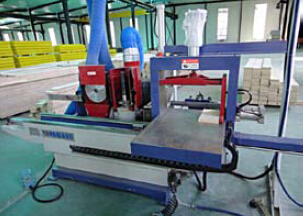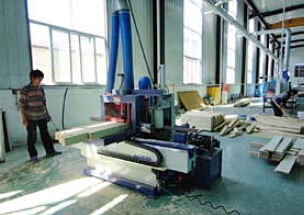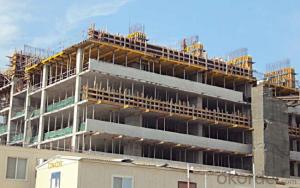Timber-Beam Formwork and H20 for formwork and scaffolding system
- Loading Port:
- Tianjin
- Payment Terms:
- TT OR LC
- Min Order Qty:
- 50 m²
- Supply Capability:
- 1000 m²/month
OKorder Service Pledge
Quality Product, Order Online Tracking, Timely Delivery
OKorder Financial Service
Credit Rating, Credit Services, Credit Purchasing
You Might Also Like
Characteristics:
◆ Standardized production lines.
Supply capability: 3000m/day, Lmax = 6600mm.
◆ Finger jointing of the flange and web, the strength of timber beam is highly improved.
Max. shearing force failure load:40KN
◆ Well treated to prevent from water penetration or erosion, so the service life maximally
extended.
Normally, CNBM timber beam H20 can be used for 4 to 5 years, the exact using time would
depend on maintenance & storage.
◆ Robust caps at the end of the girders protect against damages.




- Q:Can steel formwork be customized to specific project requirements?
- Steel formwork has the capability to be tailored according to the specific needs of a project. The versatility of steel as a material allows it to be easily shaped and crafted to meet the precise dimensions, shapes, and designs required for a particular project. As a result, intricate and distinctive formwork structures can be created, enabling the pouring of concrete in diverse sizes and shapes. Moreover, steel formwork can be modified and adjusted throughout the construction phase to accommodate any necessary modifications or alterations. The adaptability and flexibility of steel formwork render it a perfect option for projects that call for precise and personalized requirements.
- Q:Is steel formwork more environmentally friendly than other types of formwork?
- There are several reasons why steel formwork is considered to be a more environmentally friendly option than other types of formwork. Firstly, steel is an incredibly durable material that can be reused multiple times, reducing the need for constant production of new formwork materials. This helps to conserve natural resources and minimize waste. Furthermore, steel formwork has a longer lifespan compared to materials like timber or plywood, which often degrade over time and need frequent replacement. This longevity reduces the overall consumption of formwork materials and the associated environmental impact. In addition, steel formwork can be easily recycled at the end of its life, further reducing waste and minimizing the carbon footprint. The recycling process for steel is highly efficient and requires much less energy compared to the production of new steel. This results in significant energy savings and reduced greenhouse gas emissions. Moreover, steel formwork is resistant to moisture and other elements, eliminating the need for chemical treatments to protect it from decay or damage. This reduces the release of harmful substances into the environment, making steel formwork a safer and more sustainable option. However, it is important to consider that the environmental impact of steel formwork can also be influenced by factors such as the manufacturing processes used, transportation distances, and the specific requirements of a project. Therefore, it is crucial to assess the entire life cycle of the formwork and make well-informed decisions based on the specific circumstances to ensure the most environmentally friendly choice.
- Q:What are the different types of surface treatments available for steel formwork?
- There are several different types of surface treatments available for steel formwork, each offering its own unique benefits and characteristics. 1. Galvanization: This is a popular surface treatment method where a layer of zinc is applied to the steel formwork. Galvanization helps protect the steel from corrosion, extending its lifespan and enhancing its durability. It can also provide a smoother surface finish. 2. Powder coating: Powder coating involves applying a dry powder to the surface of the steel formwork, which is then heated to create a durable and protective layer. This treatment offers excellent resistance to corrosion, impacts, and chemicals, and is available in a wide range of colors. 3. Painting: Painting is a common surface treatment method where a layer of paint is applied to the steel formwork. This treatment not only provides an aesthetically pleasing finish but also helps protect the steel from corrosion and other environmental factors. 4. Epoxy coating: Epoxy coating involves applying a layer of epoxy resin to the surface of the steel formwork. This treatment offers excellent resistance to corrosion, chemicals, and abrasion. It also provides a smooth and seamless finish, making it easier to clean and maintain. 5. Shot blasting: Shot blasting is a process where steel shots are propelled at high speeds onto the surface of the steel formwork. This treatment helps remove any rust, scale, or contaminants from the surface, resulting in a clean and roughened finish. Shot blasting also improves the adhesion of subsequent surface treatments. 6. Anodizing: Anodizing is typically used for aluminum formwork but can also be applied to steel. This treatment involves creating an oxide layer on the surface of the steel formwork, which enhances its corrosion resistance and improves its appearance. Overall, the choice of surface treatment for steel formwork depends on factors such as the desired level of corrosion resistance, aesthetics, durability, and environmental conditions. Each treatment offers its own set of advantages, and it is important to consider these factors before selecting the most suitable surface treatment for your steel formwork.
- Q:How does steel formwork accommodate for different concrete pouring methods?
- Steel formwork is highly versatile and can easily accommodate different concrete pouring methods. Its modular design allows for easy adjustment and reconfiguration to match the specific requirements of each pouring method. For instance, when using the traditional method of pouring concrete, the steel formwork can be assembled and secured in place to create a sturdy mold for the concrete. Alternatively, when employing the slip forming method, the steel formwork can be continuously moved upward as the concrete is poured, ensuring a seamless and uniform construction process. Overall, steel formwork provides the flexibility and adaptability needed to accommodate various concrete pouring methods effectively.
- Q:What are the common challenges associated with steel formwork?
- Construction projects face several common challenges when it comes to steel formwork. One of the main obstacles is the high initial cost associated with purchasing or renting steel formwork compared to other materials like wood or plastic. Although steel formwork is more durable and has a longer lifespan, smaller construction companies or projects with limited budgets may find the upfront investment prohibitive. Another issue is the weight and handling of steel formwork. Due to its heaviness, transporting, assembling, and dismantling steel formwork on-site can be challenging. This may necessitate additional labor and equipment, leading to increased construction costs. Proper installation and alignment of steel formwork also require skilled labor. Achieving the desired dimensions and finishes of concrete structures relies heavily on the accuracy and precision of the formwork. Mistakes or misalignments during setup can result in costly rework or compromised structural integrity. Maintenance and storage of steel formwork pose their own challenges. Regular cleaning and treatment are necessary to prevent rust and corrosion, particularly in humid or coastal areas. Sufficient storage space is also essential for protecting the formwork from external elements when not in use. Lastly, customization and adaptability can prove challenging with steel formwork. Unlike wood formwork, which can be cut and shaped on-site, steel formwork requires prefabrication and customization before use. Any changes in design or dimensions during the construction process may require additional time and cost to modify or replace the steel formwork components. Despite these challenges, steel formwork offers numerous advantages, including durability, reusability, and high-quality finishes. By implementing proper planning, training, and maintenance, these challenges can be effectively managed to ensure the success of construction projects.
- Q:Can steel formwork be used for retaining walls?
- Yes, steel formwork can be used for retaining walls. Steel formwork offers durability, strength, and flexibility, making it suitable for constructing retaining walls that require a high level of stability and load-bearing capacity. Steel formwork also allows for precise shaping of the retaining wall, ensuring a smooth and uniform finish.
- Q:Can steel formwork be used in areas with high chemical exposure?
- While steel formwork can be utilized in areas characterized by high levels of chemical exposure, it may not necessarily be the most optimal selection. Although steel is generally recognized as a resilient and robust substance, it is prone to corrosion upon encountering specific chemicals. In situations where the chemicals prevalent within the vicinity are known to induce corrosion in steel, it is advisable to contemplate alternative formwork materials like plastic or aluminum, which possess a higher resistance to chemical exposure. Moreover, it is feasible to enhance the steel formwork's chemical resistance by applying protective coatings or treatments. Nonetheless, it is crucial to thoroughly assess the particular chemicals and their concentration within the area in order to ascertain the most suitable formwork material for the project.
- Q:How does steel formwork affect the overall speed of construction?
- The numerous advantages of steel formwork greatly contribute to the overall speed of construction. Firstly, its high durability ensures that it can withstand the pressure of concrete pouring without any deformation or damage. This durability allows for multiple reuses of the formwork, eliminating the need for constant replacement with new materials and saving both time and cost. Furthermore, steel formwork provides a smooth and even surface finish, which reduces the time needed for additional plastering or finishing work. This smooth finish also guarantees accurate alignment of structural elements, resulting in faster and more efficient construction. In addition, the ease of assembly and disassembly of steel formwork facilitates quick installation and removal. This user-friendly feature eliminates the need for extensive labor and minimizes the time required for formwork setup, ultimately accelerating the construction process. Moreover, steel formwork is highly adaptable and can be used in various types of building structures. Its flexibility allows for customization and efficient utilization in different construction projects, further enhancing the overall speed of construction. In conclusion, the utilization of steel formwork has a positive impact on the speed of construction by offering durability, a smooth finish, ease of assembly and disassembly, and adaptability. These advantages result in time and cost savings, efficient construction processes, and ultimately faster project completion.
- Q:Can steel formwork be used for both horizontal and vertical structures?
- Yes, steel formwork can be used for both horizontal and vertical structures. Steel formwork is versatile and can be easily adjusted and assembled to meet the requirements of different construction projects, whether they involve horizontal slabs or vertical walls and columns. Its strength and durability make it suitable for a wide range of applications in various types of structures.
- Q:Is steel formwork suitable for projects with high formwork complexity?
- Steel formwork is a great option for projects that have intricate formwork needs. It can be customized and shaped to meet the requirements of complex projects, making it ideal for structures that are curved or non-standard. Furthermore, steel formwork is strong and durable, able to withstand the pressures and loads of construction. This makes it suitable for projects that require heavy reinforcement or large concrete pours. Additionally, steel formwork provides smooth and uniform surfaces, resulting in high-quality finishes. While it may require a higher initial investment, its long lifespan and reusability make it a cost-effective choice. Overall, steel formwork is a flexible, strong, and durable option that can provide high-quality finishes for complex projects.
1. Manufacturer Overview |
|
|---|---|
| Location | |
| Year Established | |
| Annual Output Value | |
| Main Markets | |
| Company Certifications | |
2. Manufacturer Certificates |
|
|---|---|
| a) Certification Name | |
| Range | |
| Reference | |
| Validity Period | |
3. Manufacturer Capability |
|
|---|---|
| a)Trade Capacity | |
| Nearest Port | |
| Export Percentage | |
| No.of Employees in Trade Department | |
| Language Spoken: | |
| b)Factory Information | |
| Factory Size: | |
| No. of Production Lines | |
| Contract Manufacturing | |
| Product Price Range | |
Send your message to us
Timber-Beam Formwork and H20 for formwork and scaffolding system
- Loading Port:
- Tianjin
- Payment Terms:
- TT OR LC
- Min Order Qty:
- 50 m²
- Supply Capability:
- 1000 m²/month
OKorder Service Pledge
Quality Product, Order Online Tracking, Timely Delivery
OKorder Financial Service
Credit Rating, Credit Services, Credit Purchasing
Similar products
New products
Hot products
Related keywords

























